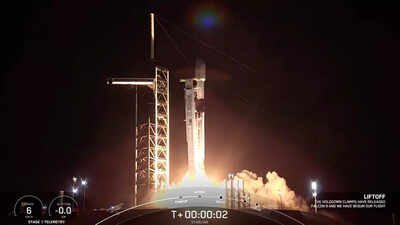SpaceX made a key milestone in delivering global internet connectivity on April 24, 2025, with the successful launch of the Starlink 6-74 mission. In the mission, 28 satellites were deployed in low Earth orbit, adding further to Spacex’s Starlink constellation. This expansion is central to the company’s mission of providing high-speed internet connectivity to even the most distant and underserved parts of the globe. With every successful deployment, SpaceX is incrementally moving closer to its vision of delivering low-latency, reliable internet to millions of individuals around the world, improving connectivity in rural communities.
SpaceX Falcon 9 launched Starlink satellites from Cape Canaveral
The rocket launched at 9:52 pm ET from Launch Complex 40 (LC-40) at Florida’s Cape Canaveral Space Force Station. The Falcon 9 rocket blasted into the evening sky, accelerated by nine Merlin engines in its initial stage. The successful launch is another milestone for SpaceX as it inches nearer to finishing its ambitious Starlink megaconstellation.
Within the nose fairing of the rocket, a neatly stacked array of 28 Starlink satellites was securely fastened. The satellites are intended to reach low Earth orbit (LEO), where they will deliver high-speed internet to large regions around the globe. As part of the expanding Starlink constellation, these satellites will improve global connectivity, especially in remote and underserved communities, by providing low-latency, reliable broadband services.
SpaceX booster successfully lands after 23rd flight, satellites deployed in orbit
Around 2.5 minutes into flight, the first stage of the rocket—a booster named B1069—finished burning its main engines and jettisoned itself from the top stage. This booster has quite a good history. The April 24 flight was its 23rd, which makes it one of the most reused Falcon 9 boosters to have flown so far.
Upon separation, B1069 started its descent to Earth. Approximately six minutes after that, it made a spot landing on the droneship “A Shortfall of Gravitas,” which was docked in the Atlantic Ocean. This was the 19th Starlink mission for B1069 and yet again highlighted the efficiency and affordability of SpaceX’s reusable rocket system. As the booster landed safely back on Earth, the Falcon 9 upper stage continued to ascend. Having the payload of 28 satellites, it entered low Earth orbit and ultimately deployed the satellites an hour after launch. From there, individual satellites will employ onboard thrusters to move into final orbit, joining the larger Starlink constellation.
SpaceX achieves record-breaking launch milestones in 2025
The Starlink 6-74 mission was not just another success of deployment—it was also SpaceX’s record-breaking year. The company’s 47th Falcon 9 launch of 2025 and its 30th Starlink-specific mission in 2025, this mission made it into the history books. This staggering rate indicates SpaceX’s industrial and logistical prowess, allowing it to take over the space launch market.
The reuse capability of boosters such as B1069 is the key to this fast pace. Reusability is key to lowering the cost of launches and making frequent launches feasible, which makes SpaceX all the more different from the rest.
Space enthusiasts and photographers flocked to places like Woodside Park in Viera, Florida, to take awe-inspiring pictures of the liftoff. Powerful lenses captured the rocket’s blazing climb, stage separation, and even the landing burn on the droneship. The mission’s visibility in the evening sky was a spectacle for skywatchers and only served to boost public interest in space exploration.
Future of Starlink and SpaceX’s broader vision
With thousands of satellites already in orbit, Starlink is set to be a global internet infrastructure leader. The network has already demonstrated potential in increasing rural and remote communities’ connectivity. As the constellation expands, Starlink is likely to bring faster speeds, wider coverage, and higher reliability—rivaling traditional ISPs.
Also Read | Mysterious ‘zombie star’ speeds through the Milky Way at 177,000 km/h, capable of ripping human atoms; origin remains unknown


